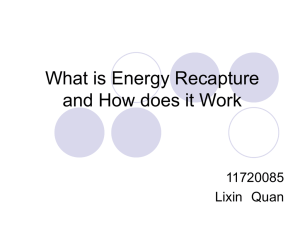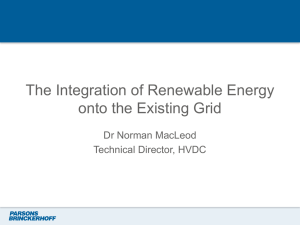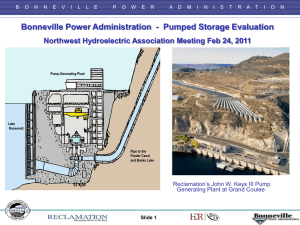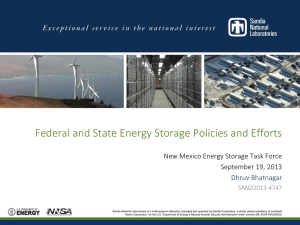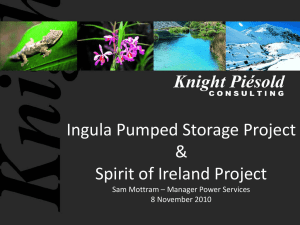Energy storage
advertisement
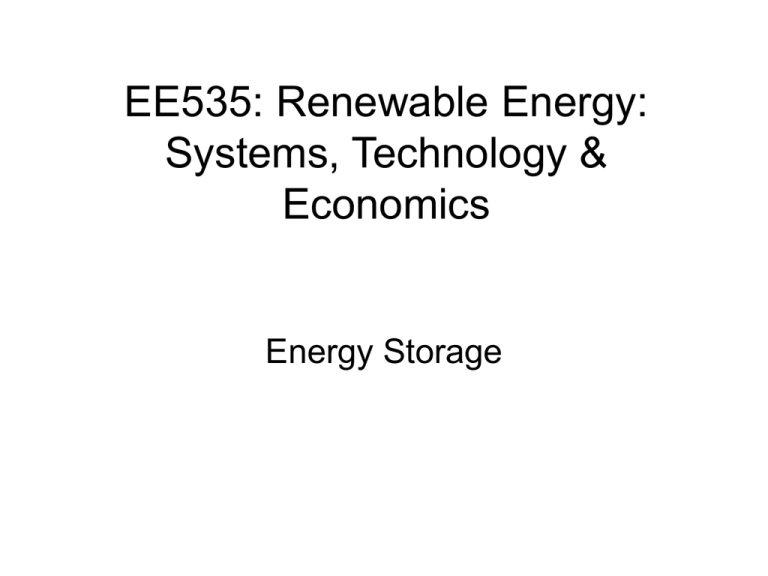
EE535: Renewable Energy: Systems, Technology & Economics Energy Storage Introduction to Storage • Energy storage is the conversion of energy to other forms so that it may be used at a later stage when required. • Industrial scale energy storage technologies are measured in terms of their power output (MW) and their capacity (MWh). • The most common type of energy storage is ‘Spinning Reserve’ where power plants operate at a level slightly below the point where they begin to produce power. This allows them to react quickly to large swings in demand. The spinning reserve is the extra generating capacity that is available by increasing the power output of generators that are already connected to the power system. For most generators, this increase in power output is • achieved by increasing the torque applied to the turbine's rotor. Comparing Storage Technologies • Most Important factors – Cost & Return on Investment – Efficiency – Cycles • Influential Factors – – – – Response Time (milliseconds to hours/days) Energy Density (Size and Space Requirements) Environmental Impact Charge Time Intermittent Wind Supply Yearly, Bi-Monthly & Monthly Wind Output (MW) • • • www.inference.phy.cam.ac.uk/withouthotair/c26/page_187.shtml Wind is not a controllable energy source, it is either blowing or it isn’t and this power is distributed to the electricity grid regardless of whether it is needed or not. The grid cannot store energy so power plants have to match the demand in real time. Often several power plants will operate in ‘Spinning Reserve’ mode during periods of high wind output to cater for the inevitable drop in wind. Source: Eirgrid •Typical 7 day Winter Demand profile (Saturday/Sunday generally lowest) •Wind Output for same time period has no correlation to demand •Issues with excess wind generation between 12.30 AM – 6AM Storage Technologies – Flywheel Energy Storage http://www.upei.ca/~physics/p261/projects/flywheel2/flywheel2.htm • Flywheels are mechanical devices which accelerate a rotor to a very high speed, storing the energy as rotational energy. • These devices are most suitable for high utilization applications as their efficiency decreases in proportion to their use. • Suitable for short term lulls in wind generation output (1-5min) • Rated for > 100,000 cycles • Used in F1 racing cars (0.1kWh, 4.6Wh/kg) Storage Technologies – Flow Batteries • • • http://www.netpowertech.com/e_menu_page.aspx?bid=4&id=10 • • Flow Batteries allow energy to be stored in two solutions existing at different electrochemical potentials. All the energy is stored in the electrolyte solutions so that the capacity is determined by the size of the electrolyte tanks The system power is determined by the size of the fuel cell stacks which can be arranged in series/parallel as required. Suitable for daily lulls in wind generation output (< 12hours) Rated for > 10,000 Cycles Storage Technologies – Pumped Storage • • • • www.hk-phy.org/energy/alternate/hydro_phy/images/pump_storage.gif • • Pumped storage is one of the oldest energy storage methods. During the night cheap electricity is used to pump water into the upper reservoir. It is then released during the day and peak times when it is more valuable. Additional features such as frequency regulation and blackstart capabilities. Pumped storage installations are capable of providing power for extended periods, from hours to several days. Rated for > 30 years Establishing Volume of Water Required • When designing a pumped storage facility for a given capacity the two most important factors are water volume and height. • If the height is doubled, only half the water volume is needed for the same power capacity. Top Reservoir Volume & Density (p) Elevation/Head (h) Power • Volume = gh / sec – Pumps/Turbines Efficiency (ɛ) Lower Reservoir Where ‘p’ is the density of water, ‘g’ is acceleration due to gravity, ‘h’ is the height drop and ‘ɛ’ is the efficiency of the turbines/pumps. Example • A pumped storage facility is proposed for construction in the west of Ireland to store excess power generated from wind farms in the area. A potential location has been identified with a head height of 250m between the upper and lower lakes. The latest Siemens turbines with an efficiency of 90% will be utilised in the construction. What volume of water is required to store 12GWh ? Solution Power Volum e/ sec gh 12x109 Volum e/ sec (1000)(9.81)(250)(0.9) 12x109 Volum e/ sec (2207250) Volum e/ sec 5437m3 Volum e(total) (5437m3 )(3600) Volum e(total) 19.6 x106 m3 Proposed Storage Techniques • • • Electric Car Grid Tie – Current generation electric vehicles are capable of storing from 5kWh up to 30kWh of capacity. Suggestions have been made that this capacity could be made available to the grid in conjunction with smart metering. Hydrogen Production – The process of extracting hydrogen from water is currently very inefficient . Energy from renewable energy sources could be used to create hydrogen and store it until it is needed for power generation or for vehicle fuel. Super Capacitors – These devices can be used for storing small amounts of electrical energy in applications where hundreds of thousands of cycles would be common. Area’s such as regenerative braking in vehicles with many stops/starts are suitable for these devices. Turlough Hill (Wicklow Mountains) • • • • http://www.esb.ie/img/2.3.1_Turlough-Hill_800x600.jpg e 4x73MW Turbines 292MW for 5 hours Head ~280m Provides: – – – – Load levelling Peak Shaving Frequency Regulation Black Start capability • Running since 1974
